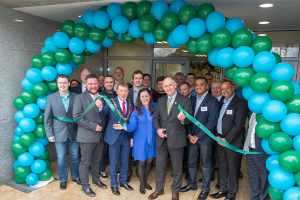HP’s David Scott on the different flavors of enterprise storage | #HPDiscover
![]() As senior vice president and general manager of HP Storage, David Scott is at the forefront of industry change, with a finger firmly on the pulse of enterprise demand. In his latest appearance on SiliconANGLE’s theCUBE, the executive went in-depth on the storage trends he will be focusing on in 2014 and beyond with hosts John Furrier and Dave Vellante.
As senior vice president and general manager of HP Storage, David Scott is at the forefront of industry change, with a finger firmly on the pulse of enterprise demand. In his latest appearance on SiliconANGLE’s theCUBE, the executive went in-depth on the storage trends he will be focusing on in 2014 and beyond with hosts John Furrier and Dave Vellante.
Formerly the general manager of Hewlett-Packard’s XP business, Scott rejoined the company after the 2010 acquisition of 3PAR, where he served as CEO. He reports that the firm’s technology has helped HP offset declining demand for its traditional systems, with positive overall growth in the last quarter hinting of light at the end of the tunnel. Pressured to show progress, CEO Meg Whitman is making the most out of 3PAR’s technology, delivering what Scott calls polymorphic simplicity through a multi-purpose architecture that is just as well equipped for use by mid-sized companies as it is by large enterprises.
“One of the key elements of a polymorphic architecture is that it actually has to start at the high-end. It’s gonna be a multiple-controller architecture, because then you can bring it down, and if you’re forensic enough about the process, [then] as you bring it down scale you manage to lose none of the critical functionality but you are able to reach price points or different performance points that can add specific value to different customers,” Scott explains.
Polymorphism is what sets HP apart from the pack, he continues, notably EMC, which addresses different use cases with separate architectures. This makes it more difficult for customers to manage their infrastructure and adds unnecessary overhead across the board, according to Scott. The unified approach of 3PAR has helped the company grow from $190 million in annual revenue at the time of the acquisition to over a billion today. Furthermore, the massive demand from partners and customers is providing HP with the momentum it needs to refocus on emerging opportunities like software-led infrastructure, which has also drawn the attention of rivals. Scott believes that his company has the lead thanks to its immensely popular ProLiant server line and the complementary StoreVirtual VSA platform.
“The difference with software-defined data center is [that] now you’re able to hand control to the application, or some kind of API, so you now have potential admin control, user control and application control. And we feel that we’re in a very very strong position as an infrastructure supplier in this evolution,” Scott says. “Why? Because to have control dynamically, you have to be able to monitor the infrastructure … you need to have the control of the core converged infrastructure itself. And that is what HP has.”
While not central to HP’s vision for the software-defined data center, 3PAR constitutes a core pillar of the hardware giant’s flash strategy. Originally designed in the early 2000s to reduce latency in spinning disk environments, the firm’s unique storage architecture addresses the performance, durability and efficiency requirements all-flash arrays have to meet, Scott says.
See the full interview here:
A message from John Furrier, co-founder of SiliconANGLE:
Your vote of support is important to us and it helps us keep the content FREE.
One click below supports our mission to provide free, deep, and relevant content.
Join our community on YouTube
Join the community that includes more than 15,000 #CubeAlumni experts, including Amazon.com CEO Andy Jassy, Dell Technologies founder and CEO Michael Dell, Intel CEO Pat Gelsinger, and many more luminaries and experts.
THANK YOU











